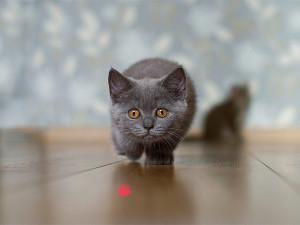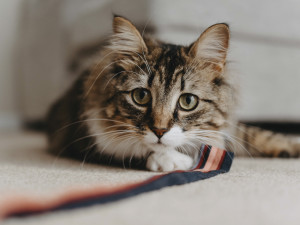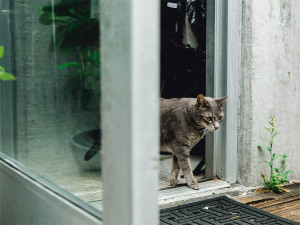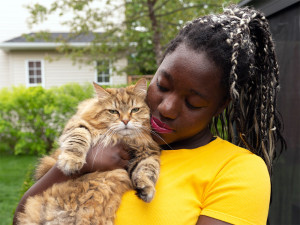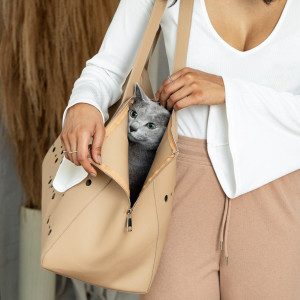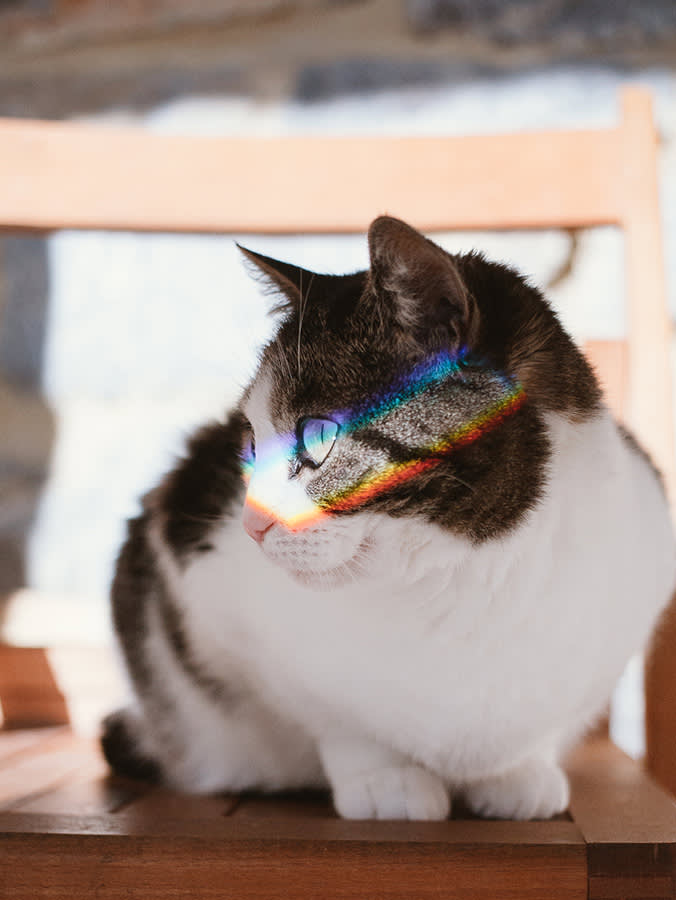
Share Article
Have you ever wondered what your cat sees when they look at you (other than a full-time chef and litter box cleaner, of course)? Is a cat’s world in full vibrant colour just like ours, or is their view just shades of black and grey, like The Wizard of Oz before Dorothy steps into a magical land?
While cats can certainly see colour, the rainbow spectrum is a bit more muted in their eyes. Similar to dogs, cats’ vision is much more limited than human vision, but they have stronger senses in other areas, such as seeing in low light. But just how many colours can cats see compared to humans?
What colours can cats see?
Cats don’t see as many coloursopens in new tab as humans do, but which colours can they see best? Your beloved feline can likely make out varying shades of blue, green and yellow, but red, orange and brown are imperceptible to their eyes. And even the colours that cats do see don’t appear in the same richness of hues and saturation that human eyes perceive, making the cat colour spectrum much more muted.
So, how do cats see colour? Humans and cats both have two types of colour receptors in their eyes: rods and cones. Rods handle how much you can see in the dark and your peripheral vision, while cones determine your vision during the day and your colour perception. Humans have more cones than cats, which means that they can usually see the whole spectrum of light in all its vibrant hues. Cats have more rods, allowing them to pick up movement more easily and see in lower light.
Humans also have three photopigment receptors in their eyes, while cats only have twoopens in new tab, limiting the colour spectrum they see. However, cats easily win over humans in their ability to notice small, fast movements and see clearly in dim lighting, both of which contribute to their excellent hunting skills.
Why can’t cats see red?
The colour-detecting conesopens in new tab in a cat’s eyes are most sensitive to blue-violet and yellow-green wavelengths of light. Unlike humans, cats don’t have cones sensitive to red light wavelengths, which prevents them from seeing red. So, if your cat enjoys chasing a laser pointer around the house, they don’t actually see the colour of the light. Instead, they’re just responding to the rapid movement.
Can cats distinguish between different shades of blue and green?
Just like dogs, cats’ colour vision is primarily in shades of yellow, blue and grey, although cats tend to perceive more blue and greenish-yellow hues, while dogs’ vision focuses more on blue and yellow.
But just how many colours can a cat see and what colours do cats see in? While scientists are still uncertain just how many shades of green cats can perceive, they most likely have a vision spectrum similar to that of a colour-blind human. This means the shades they do see are muted, and they‘re unable to perceive red or pink, which may look more like green to their eyes. And even a bright purple may seem like just another shade of blue to your cat.
Does a cat’s colour vision affect their behaviour?
Cats tend to rely more on their ability to detect movement, as well as seeing in dim lighting, than on their colour vision. While your cat may not be aware of the bright colours that you can see each day, they can still sneak up on you in the dark and practice their hunting skills by chasing moving toys. Most likely, your cat doesn’t know what they’re missing and gets through their days just fine with the vision they do have, muted colours and all.
How does this affect cats?
Cats have other senses that help them to compensate for their lack of colour perception, such as their hearing and their sense of smell.
As a cat parent, you may be tempted to choose toys with bright colours because they appeal to your vision spectrum, but your cat likely won’t be excited by a bright red mouse. Instead, look for toys that move to engage your cat’s hunting instincts, and if you want to choose colourful toys they can enjoy, stick with shades of yellow and blue. Or, better yet, opt for interactive toys that stimulate your cat’s natural predator instincts and let them feel like the stealthy hunters they are.
Can cats see in the dark?
It’s a common belief that cats can see in the dark, which may contribute to their often spooky reputation. While cats can’t see in complete darkness, they are able to see six times betteropens in new tab than humans in low light because they have a much larger number of rod cells in their eyes.
Cats also have a thin, reflective layer along the back of their eye, known as a tapetumopens in new tab, which magnifies light in darker spaces, reflecting that light like a mirror. This layer is the reason why cats’ eyes – and the eyes of dogs and many other animals – appear to glow in the dark. This reflective layer also helps cats to see more easily in dim light.
So, even if your cat can’t enjoy all the colours of the rainbow, they can still use their eyes to show you just how much they trust you – and you can return the favour.
Frequently asked questions
What colours can cats see?
Cats primarily see muted shades of blue-violet and yellow-green but are unable to perceive red, orange and brown.
Can cats see in black and white?
Cats are not fully colourblind, so their world isn’t black and white but is instead tinged with yellow, blue and grey.
Do cats see the same colours as dogs?
Cats and dogs both see in the same limited colour palettes and struggle to perceive red, but cats tend to see more shades of green and yellow than dogs.
Can cats distinguish between different shades of blue and green?
Cats can distinguish between some shades of blue, but scientists still debate whether they can pick out different shades of green.
Does a cat’s colour vision affect their behaviour?
Your cat may respond better to objects within their range of colour vision, but cats overall rely more on their perception of movement.
Can cats see in the dark?
While cats don’t have night-vision, they can see in dim light much better than humans.
Can I use specific colours to attract my cat’s attention?
Cats will likely be more interested in blue and yellow toys than red ones, but the best way to get your cat’s attention is to stand right in front of them where their vision is best.
References

Savannah Admire
Savannah Admire is a writer, poet, and pet mom to three dogs and a cat. She currently lives in Western Maryland. When she’s not writing, you can find her reading, taking photos, or volunteering as a content creator for her local community theatre. Her debut poetry book, Mother Viper, is forthcoming on August 12, 2025.
Related articles
Cat Allergies: Do Hypoallergenic Cats Exist?
If the sniffles are getting you down, don’t stress: you have options
![A gray cat in a tan cat carrier]()
Your Cat Doesn’t Have to Hate Their Carrier
A behaviourist’s six surefire steps to training a cat to go in a carrier
![Cat sitting in a teal litter box]()
Mastering the Art of Litter Box Training: How to Train Cats to Use a Litter Box
If you do nothing else, teach your cat to poo in their litter box (and not in your shoe)
![Training a cat sitting with leash and harness on.]()
A Step-by-Step Guide On How to Clicker Train Your Cat
This popular training technique isn’t just for dogs. Here’s how you can make it work for your cat
What to Know About Runny Noses in Cats
Nasal discharge doesn’t sound cute, but you need to know what to look out for
![Young woman hugging her cat]()
Why Do Cats Purr?
Surprise: it doesn’t always mean they’re happy


